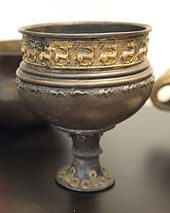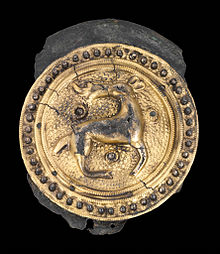Disc brooch from Tangendorf
The Tangendorf disc brooch is a disc brooch from the 3rd century, which was found in 1930 when a Bronze Age burial mound near Tangendorf , municipality of Toppenstedt in the district of Harburg in Lower Saxony . The elaborately crafted clasp ( fibula ) has a four-legged animal looking back, probably a dog or deer , on its front . It is one of the most important finds of the Roman Empire in the Harburg district and is shown in the permanent archaeological exhibition of the Hamburg Archaeological Museum in Hamburg-Harburg .
Find history
The site is on the parcel in the black thorn at the northwest corner of the Tangendorfer Feldmark , where the farmer Heinrich Wille found the disc fibula together with a hair-knot fibula and a lance tip in 1930 when the Bronze Age burial mound was cleared from his field . The topknot brooch and the lance tip were handed over to the Helms Museum, but the disc brooch remained with the Tangendorf teacher Heinrich Versemann, who considered it a modern object.
In the summer of 1938, Museum Director Willi Wegewitz was asked by Versemann to pick up a stone ax . When the stone ax was handed over, the disc brooch lying between gymnastic equipment was rediscovered in the lowest part of the school cupboard. The teacher actually wanted to throw them away earlier because he thought they were worthless.
Wegewitz initiated a re-excavation of the burial mound, which was originally 16 meters in diameter and whose standing area was still clearly visible on the plowed field. Further remains of a topknot brooch could be recovered. Questioning the farmer Wille revealed that he had found the fibula on the edge of the burial mound at the level of the natural ground in the sand; he did not notice any discoloration of the earth or the remains of a funeral urn.
Location: 53 ° 18 ′ 7.3 ″ N , 10 ° 4 ′ 34.5 ″ E
Findings
The disc brooch is made up of several layers. On the face side, it consists of a fire-gilded very thin pressed silver sheet with a diameter of 58 mm, which is riveted with three silver rivet pins on an equally large 3 mm thick copper plate and with this on another, stronger silver plate. The needle apparatus was mounted on this rear plate, which is 78 mm in diameter and is significantly larger than the two plates on the front side. The press sheet on the front side is lined with a whitish green filling compound made of tin , lead and traces of copper on the copper plate to stabilize the sensitive driving work and to prevent the embossed decorations. However, the tin inlay cracked open parts of the pressed sheet metal decorations during the floor storage after the tin reacted allotropically to low temperatures in the ground ( tin plague ). The pressed-in decoration consists of a four-footed animal pointing to the right, with its head looking far back. The animal depicted with two ears sticks out its tongue wide from its long mouth . It has a collar-like decoration around its neck. The legs are positioned under the body according to the round shape of the picture surface. The background is decorated with irregularly distributed impressions that imitate granulation . The scene is enclosed by two ribbed bands, which in turn are enclosed by a wreath of rosette-shaped decorations and another ribbed band. The three rosette-shaped heads of the rivets are distributed around the animal's body. The body of the animal shows a major crack from the degenerated tin filling. A few places have broken off from the protruding edge of the rear carrier plate. Small remains of an organic material were preserved below the copper plate , which were interpreted as ivory . Based on typological comparisons of the decorations, the fibula was dated to around 300 AD .
interpretation
Improper salvage without precise documentation of the context of the find makes more precise statements about the individual find complexes of the Bronze Age main burial and the Iron Age subsequent burial more difficult . It is also no longer possible to determine how many grave goods were lost. Compared to similar finds, these burials usually should have contained other jewelry and utensils. Based on the statements of Willes, a cremation or body grave in the grave with the disc fibula is presumed to be a subsequent burial at an older burial mound, which is also well documented from other Iron Age grave finds. The Tangendorf disc brooch is a high-quality, most likely Germanic goldsmith's work , which was inspired by Roman models. The depicted animal is interpreted as a dog or an antlerless deer. The background for the representation of retrospective animals in Germanic art is possibly to be found in mythological ideas, but it can also be due to the fact that the animal body can be represented larger in a circle. The protruding edge of the rear silver disc, as well as the remains of organic material below the copper disc suggest that the front side of the fibula was surrounded by an approximately 10 mm wide ring made of ivory, which was also decorated.
Comparative finds

A similar disc fibula with a diameter of 55 mm comes from a body grave in Häven ( Mecklenburg-Western Pomerania ), but in which the animal looks forward. The similarities in workmanship and decoration with the Tangendorfer fibula were so striking that Wegewitz suspected they were made in the same workshop. There are parallels to the depicted animal from archaeological finds on two silver goblets from the Danish town of Valløby , as well as another from Nordrup ( Zealand (Denmark) ), a belt fitting from the Swedish Skedemosse , a drawing on a quadratic shard of vessel from the 2nd century from Prikas, Olomouc , Moravia and on the gold bracteaten of Ponsdorf, Mistelbach district , Lower Austria . The Tangendorf disc fibula is one of the most splendid fibulae from the Roman Empire in Northern Germany and Scandinavia.
Replica
After detailed analysis of the construction of the Tangendorf disc brooch, Hans Drescher made two reconstruction attempts that were true to the material in 1953 , one copy remained at the Helms Museum and the second went to the Lower Saxony State Museum in Hanover . According to the results of the research, Drescher used ivory for the organic ring, whose white color creates a decorative contrast to the gold on the metal face. Drescher presented the findings from his reconstruction work in an article in 1955.
reception
The municipality of Toppenstedt has had the stylized disc brooch from Tangendorf in its municipal coat of arms since 2002 .
literature
- Rüdiger Articus, Jochen Brandt, Elke Först, Yvonne Krause, Michael Merkel, Kathrin Mertens, Rainer-Maria Weiss: Archaeological Museum Hamburg, Helms Museum: A tour through the ages . In: Rainer-Maria Weiss (ed.): Publications of the Archaeological Museum Hamburg Helms-Museum . No. 101 . Hamburg 2009, ISBN 978-3-931429-20-1 , pp. 52 .
- Ralf Busch (ed.): Hidden treasures in the collections . 100 years of the Helms Museum. Wachholtz, Neumünster 1998, ISBN 3-529-02001-X , p. 74-75 .
- Willi Wegewitz : The disc fibula and the cemetery of Tangendorf . In: The Adventure of Archeology . Isensee, Oldenburg 1994, ISBN 3-89442-230-0 , p. 362-364 .
- Willi Wegewitz : The Tangendorf Disc Primer . In: Hammaburg NF . No. 8 , 1988, ISBN 3-529-01356-0 , ISSN 0173-0886 , pp. 148-150 .
- Hans Drescher: The replica of the disc brooch from Tangendorf . In: Lower Saxony Regional Association for Prehistory (ed.): The customer NF . No. 6 , 1955, ISSN 0342-0736 , p. 25-33 .
- Willi Wegewitz : The disc fibula from Tangendorf, district of Harburg . In: Lower Saxony State Association for Prehistory (Hrsg.): The customer . tape 9 , no. 2 , 1941, ISSN 0342-0736 , p. 36-41 .
- Willi Wegewitz : The disc primer from Tangendorf in the Harburg district. In: Harburg district calendar. 1957, pp. 81-84.
Web links
Individual evidence
- ↑ Helms-Museum inventory number: 63472 (after Wegewitz 1941)
- ↑ Subject area Innovation, Showcase No. 32.
- ^ Rüdiger Articus, Jochen Brandt, Elke Först, Yvonne Krause, Michael Merkel, Kathrin Mertens, Rainer-Maria Weiss: Archäologisches Museum Hamburg, Helms-Museum: A tour through the ages (= publications of the Archaeological Museum Hamburg Helms-Museum . No. 101 ). Hamburg 2009, ISBN 978-3-931429-20-1 , pp. 52 .
- ↑ Photo of a typical topknot primer on Wikimedia Commons : File: Hairknot primer Bahrendorf.jpg
- ↑ a b c d Willi Wegewitz : The disc fibula from Tangendorf, district Harburg . In: Lower Saxony State Association for Prehistory (Hrsg.): The customer . tape 9 , no. 2 , 1941, ISSN 0342-0736 , p. 36-41 .
- ↑ a b c d e f Willi Wegewitz : The Tangendorf disc fibula . In: Hammaburg NF . No. 8 , 1988, ISBN 3-529-01356-0 , ISSN 0173-0886 , pp. 148-150 .
- ↑ Hamburg Archaeological Museum: Tangendorf local file : Gauss-Krüger Coordinates: 3571 825 5908330.
- ↑ Metalbægre. In: National Museum Samlinger Online. National Museum of Denmark, accessed May 20, 2016 .
- ↑ Sophus Müller : Ordning af Danmarks Oldsager: II, Jernaderen - 1888-1895 . CA Reitzel, Kjoebenhavn 1895, p. Fig. 313 (Danish).
- ^ Wijnand van der Sanden : Mummies from the moor. The prehistoric and protohistoric bog bodies from northwestern Europe . Batavian Lion International, Amsterdam 1996, ISBN 90-6707-416-0 , pp. 85 (Dutch, original title: Vereeuwigd in het veen . Translated by Henning Stilke). (Also looking back, with tongue stretched out, collar and legs crossed)
- ↑ Hans Drescher: The replica of the disc fibula from Tangendorf . In: Lower Saxony Regional Association for Prehistory (ed.): The customer NF . tape 6 , no. 2 , 1955, ISSN 0342-0736 , p. 25-33 .
- ↑ Official Journal for the Harburg District, No. 7, Volume 31, February 21, 2002, Page 145, Section 2.


